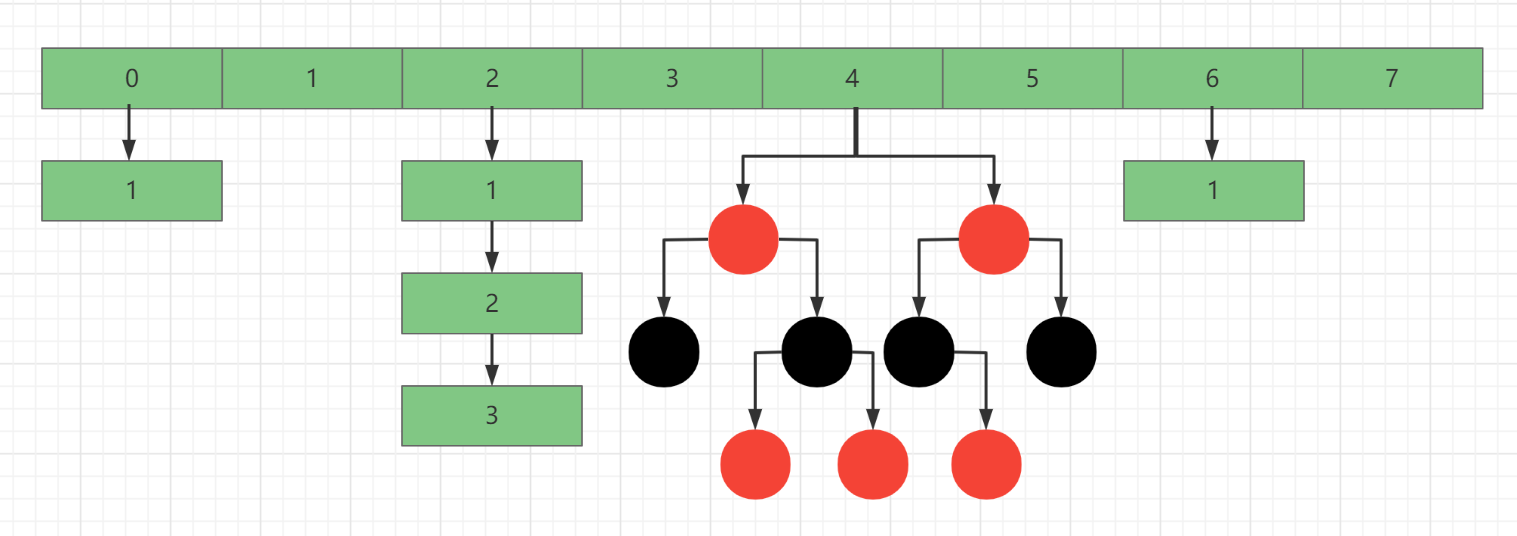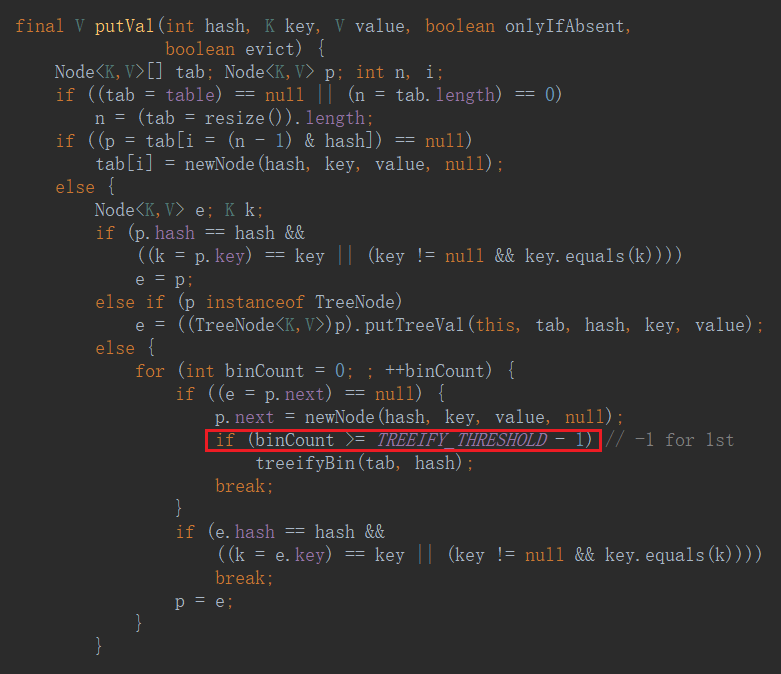java.util.HashMap源码一直是面试必问的项目,包括底层数据结构、扩容机制,以及为什么线程不安全等。本文作为JDK源码分析系列的开端,首先从HashMap开始,对其源码进行剖析。源码基于JDK1.8
关于红黑树的部分,本文由于篇幅有限,不再展开。
在介绍具体方法前,有必要说明下hashMap的数据结构。
hashMap 内部的最小单元是java.util.HashMap.Node,Node部分源码如下
1 2 3 4 5 6 7 8 9 10 11 12 13 static class Node <K,V> implements Map .Entry<K,V> { final int hash; final K key; V value; Node<K,V> next; Node(int hash, K key, V value, Node<K,V> next) { this .hash = hash; this .key = key; this .value = value; this .next = next; } }
Node用于存储每个键值对,每个Node除了key、value外,还保存有自身key的hash值,以及指向下一个Node的引用next。
在JDK1.8中,hashMap 本质是由 Node 组成的 数组+链表+红黑树 的混合体。
因此,hashMap 中的方法,其实都是对这个混合体所做的增删改查。
Node数组,hashMap 的主体
1 transient Node<K,V>[] table;
所有键值对的引用,并没有真的存放键值对
1 transient Set<Map.Entry<K,V>> entrySet;
所有Node的数量,包括数组、链表和红黑树中的Node,与Node数组长度没有关系
记录hashMap 被修改的次数
扩容阈值,当Node数量达到这个值,则触发扩容
负载系数,决定了扩容阈值的大小,loadFactor = threshold / table.length
默认数组长度,16
1 static final int DEFAULT_INITIAL_CAPACITY = 1 << 4 ;
最大数组长度,1 << 30 = 1073741824
1 static final int MAXIMUM_CAPACITY = 1 << 30 ;
默认负载系数,0.75
1 static final float DEFAULT_LOAD_FACTOR = 0.75f ;
链表转红黑树的长度,不带头结点是8
1 static final int TREEIFY_THRESHOLD = 8 ;
红黑树转链表的长度,不带头结点是6
1 static final int UNTREEIFY_THRESHOLD = 6 ;
链表转红黑树要求的最小数组长度是64,当小于这个值会优先扩容
1 static final int MIN_TREEIFY_CAPACITY = 64 ;
hashMap构造方法有四种,按是否初始化table,可以分为两类
第一类在创建对象阶段只是定义initialCapacity或loadFactor的值,并不初始化table数组。而要等到第一次put操作时才初始化。是一种延迟加载的思想。
无参构造,设定负载系数为默认值
1 2 3 public HashMap () { this .loadFactor = DEFAULT_LOAD_FACTOR; }
可设定初始化table数组的长度,同时设定负载系数为默认值。内部调用构造三
1 2 3 4 public HashMap (int initialCapacity) { this (initialCapacity, DEFAULT_LOAD_FACTOR); }
可设定初始化table数组的长度以及负载系数。需要注意initialCapacity不是实际的数组长度
1 2 3 4 5 6 7 8 9 10 11 public HashMap (int initialCapacity, float loadFactor) { if (initialCapacity < 0 ) throw new IllegalArgumentException ("Illegal initial capacity: " + initialCapacity); if (initialCapacity > MAXIMUM_CAPACITY) initialCapacity = MAXIMUM_CAPACITY; if (loadFactor <= 0 || Float.isNaN(loadFactor)) throw new IllegalArgumentException ("Illegal load factor: " + loadFactor); this .loadFactor = loadFactor; this .threshold = tableSizeFor(initialCapacity); }
重点介绍下tableSizeFor方法,该方法作用是,返回大于给定参数的最小的二次幂。
例如cap=3,返回4;cap=9,返回16;cap=25,返回32。这样不论传入的值是多少,都能保证数组的长度是二次幂。
1 2 3 4 5 6 7 8 9 static final int tableSizeFor (int cap) { int n = cap - 1 ; n |= n >>> 1 ; n |= n >>> 2 ; n |= n >>> 4 ; n |= n >>> 8 ; n |= n >>> 16 ; return (n < 0 ) ? 1 : (n >= MAXIMUM_CAPACITY) ? MAXIMUM_CAPACITY : n + 1 ; }
关于方法实现原理,参考HashMap的tableSizeFor()方法原理
将Map转换成HashMap,会在添加元素之前先初始化table数组
首先设定负载系数为默认值
1 2 3 4 public HashMap (Map<? extends K, ? extends V> m) { this .loadFactor = DEFAULT_LOAD_FACTOR; putMapEntries(m, false ); }
然后调用putMapEntries方法,在putVal方法内初始化table并将map中的元素添加到hashMap中
1 2 3 4 5 6 7 8 9 10 11 12 13 14 15 16 17 18 19 20 21 22 final void putMapEntries (Map<? extends K, ? extends V> m, boolean evict) { int s = m.size(); if (s > 0 ) { if (table == null ) { float ft = ((float )s / loadFactor) + 1.0F ; int t = ((ft < (float )MAXIMUM_CAPACITY) ? (int )ft : MAXIMUM_CAPACITY); if (t > threshold) threshold = tableSizeFor(t); } else if (s > threshold) resize(); for (Map.Entry<? extends K , ? extends V > e : m.entrySet()) { K key = e.getKey(); V value = e.getValue(); putVal(hash(key), key, value, false , evict); } } }
put方法整体逻辑如下:
先根据key的hashCode计算hash值,再根据hash值与数组最大索引的与运算,计算节点在数组中的位置;
如果该位置为空,则直接加入节点;
如果该位置有节点,则判断key是否相同,相同则替换节点value;
如果key不同,则继续判断链表的下一个节点key是否相同;
直到遍历到尾节点,将当前节点放在链表末尾;
如果链表长度(包括头节点)>=9且数组长度 < 64,则执行扩容;
如果链表长度(包括头节点)>=9且数组长度 >= 64,则将当前链表转为红黑树;
如果节点数 > 扩容阈值,则扩容。
1 2 3 public V put (K key, V value) { return putVal(hash(key), key, value, false , true ); }
这里不是直接使用的hashCode。h是一个32位的数,h >>> 16 表示h的高16位,h ^ (h >>> 16)表示h的低16位与高16位进行异或运算,作为新的低16位,原有的高16位在异或运算后保持不变。目的在于使结果更加离散。
1 2 3 4 static final int hash (Object key) { int h; return (key == null ) ? 0 : (h = key.hashCode()) ^ (h >>> 16 ); }
调用putVal方法,将键值对添加到数组中。
1 2 3 4 5 6 7 8 9 10 11 12 13 14 15 16 17 18 19 20 21 22 23 24 25 26 27 28 29 30 31 32 33 34 35 36 37 38 39 40 41 42 43 44 45 46 47 48 49 50 51 52 53 54 55 56 57 58 59 60 61 final V putVal (int hash, K key, V value, boolean onlyIfAbsent, boolean evict) { Node<K,V>[] tab; Node<K,V> p; int n, i; if ((tab = table) == null || (n = tab.length) == 0 ) n = (tab = resize()).length; if ((p = tab[i = (n - 1 ) & hash]) == null ) tab[i] = newNode(hash, key, value, null ); else { Node<K,V> e; K k; if (p.hash == hash && ((k = p.key) == key || (key != null && key.equals(k)))) e = p; else if (p instanceof TreeNode) e = ((TreeNode<K,V>)p).putTreeVal(this , tab, hash, key, value); else { for (int binCount = 0 ; ; ++binCount) { if ((e = p.next) == null ) { p.next = newNode(hash, key, value, null ); if (binCount >= TREEIFY_THRESHOLD - 1 ) treeifyBin(tab, hash); break ; } if (e.hash == hash && ((k = e.key) == key || (key != null && key.equals(k)))) break ; p = e; } } if (e != null ) { V oldValue = e.value; if (!onlyIfAbsent || oldValue == null ) e.value = value; afterNodeAccess(e); return oldValue; } } ++modCount; if (++size > threshold) resize(); afterNodeInsertion(evict); return null ; }
重点看一下这一句,将数组长度-1和hash值进行与运算
1 p = tab[i = (n - 1 ) & hash]
由于n始终是2的m次方,所以n-1的二进制一定是111…111(m个)。而与运算的规则是都为1则是1,所以(n - 1) & hash的结果其实取决于hash值的低m位(从右往左数),所以(n - 1) & hash的结果在000…000(m个)到111…111(m个)之间。也就是说i的值在0到n-1之间。
相比hashTable中用hash值对数组长度取余的做法,虽然也能获得在数组中的位置,但位运算显然更高效。
1 int index = (hash & 0x7FFFFFFF ) % tab.length;
在putVal方法中可以看到,当链表长度(包含头结点)>=9时 ,会进入treeifyBin方法
代码中判断条件是if(binCount >= 7),
第一次进入循环时,节点数是2(p和e),对应binCount =0;
最后一次进入循环时,节点数是9(到p是8个,再加上newNode),对应binCount =7.
treeifyBin方法转红黑树前会先判断数组长度是否达到64。
如果数组长度 < 64,优先扩容(避免过早引入红黑树)。
如果数组长度 >= 64,则执行链表转红黑树逻辑。
具体逻辑是:先将普通节点Node转换成红黑树节点TreeNode,然后补充prev属性,将单向链表转换成双向链表,最后通过TreeNode#treeify方法将双向列表转换成红黑树。
源码如下:
1 2 3 4 5 6 7 8 9 10 11 12 13 14 15 16 17 18 19 20 21 22 23 24 25 26 27 28 final void treeifyBin (Node<K,V>[] tab, int hash) { int n, index; Node<K,V> e; if (tab == null || (n = tab.length) < MIN_TREEIFY_CAPACITY) resize(); else if ((e = tab[index = (n - 1 ) & hash]) != null ) { TreeNode<K,V> hd = null , tl = null ; do { TreeNode<K,V> p = replacementTreeNode(e, null ); if (tl == null ) hd = p; else { p.prev = tl; tl.next = p; } tl = p; } while ((e = e.next) != null ); if ((tab[index] = hd) != null ) hd.treeify(tab); } }
当HashMap中数组未初始化,或节点数超出阈值,或链表长度达到8而数组长度不到64时,会触发扩容。
每次扩容,新数组长度总是旧数组的两倍,且数组长度为2的幂次方。因此在扩容后,节点在数组中的位置只有两种可能:保持不变或移动一个旧数组长度。
相对应的,HashMap提供了扩容方法,却没有提供缩容方法,即数组长度只能增大不能减小。
扩容的逻辑如下:
初始化新数组,其长度是旧数组的两倍
从旧数组索引为0开始,遍历数组节点
节点为空,则移动到数组下一位
只有一个节点,则重新计算节点的索引,并放置到新数组上
不止一个节点,则判断节点类型
如果是树节点,则调用树节点的拆分方法,将红黑树拆分成两棵(或一棵)。如果树中节点数<=6,则转换成链表。最后放到新数组对应的位置上
如果是链表节点,则重新计算每个节点的索引,拆分成两条链表(或一条)。最后放到新数组对应的位置上
由于扩容是按照链表的方向进行,因此链表的顺序在扩容后依然得到保证,即在同一条链表(或红黑树)中,先插入节点始终在后插入节点的前面
1 2 3 4 5 6 7 8 9 10 11 12 13 14 15 16 17 18 19 20 21 22 23 24 25 26 27 28 29 30 31 32 33 34 35 36 37 38 39 40 41 42 43 44 45 46 47 48 49 50 51 52 53 54 55 56 57 58 59 60 61 62 63 64 65 66 67 68 69 70 71 72 73 74 75 76 77 78 79 80 81 82 83 84 85 86 87 88 89 90 91 92 93 94 95 96 97 98 99 100 101 102 103 104 105 106 107 108 109 110 111 112 113 114 final Node<K,V>[] resize() { Node<K,V>[] oldTab = table; int oldCap = (oldTab == null ) ? 0 : oldTab.length; int oldThr = threshold; int newCap, newThr = 0 ; if (oldCap > 0 ) { if (oldCap >= MAXIMUM_CAPACITY) { threshold = Integer.MAX_VALUE; return oldTab; } else if ((newCap = oldCap << 1 ) < MAXIMUM_CAPACITY && oldCap >= DEFAULT_INITIAL_CAPACITY) newThr = oldThr << 1 ; } else if (oldThr > 0 ) newCap = oldThr; else { newCap = DEFAULT_INITIAL_CAPACITY; newThr = (int )(DEFAULT_LOAD_FACTOR * DEFAULT_INITIAL_CAPACITY); } if (newThr == 0 ) { float ft = (float )newCap * loadFactor; newThr = (newCap < MAXIMUM_CAPACITY && ft < (float )MAXIMUM_CAPACITY ? (int )ft : Integer.MAX_VALUE); } threshold = newThr; @SuppressWarnings({"rawtypes","unchecked"}) Node<K,V>[] newTab = (Node<K,V>[])new Node [newCap]; table = newTab; if (oldTab != null ) { for (int j = 0 ; j < oldCap; ++j) { Node<K,V> e; if ((e = oldTab[j]) != null ) { oldTab[j] = null ; if (e.next == null ) newTab[e.hash & (newCap - 1 )] = e; else if (e instanceof TreeNode) ((TreeNode<K,V>)e).split(this , newTab, j, oldCap); else { Node<K,V> loHead = null , loTail = null ; Node<K,V> hiHead = null , hiTail = null ; Node<K,V> next; do { next = e.next; if ((e.hash & oldCap) == 0 ) { if (loTail == null ) loHead = e; else loTail.next = e; loTail = e; } else { if (hiTail == null ) hiHead = e; else hiTail.next = e; hiTail = e; } } while ((e = next) != null ); if (loTail != null ) { loTail.next = null ; newTab[j] = loHead; } if (hiTail != null ) { hiTail.next = null ; newTab[j + oldCap] = hiHead; } } } } } return newTab; }
重点:
在链表只有一个节点时,通过下面这句确定新e在新数组中的位置
1 newTab[e.hash & (newCap - 1 )] = e;
这一句非常巧妙,newCap - 1的二进制是111…111(n+1个),oldCap - 1的二进制是111…111(n个),前者比后者多一个1位。所以e.hash & (newCap - 1)和e.hash & (oldCap - 1)的差别关键就在hash值的最高位上。最高位为0则结果相同,最高位为1则二者相差一个最高位的1,而这个1表示的大小正好就是2^n=oldCap。
所以扩容的结果就是:这个节点要么位置不变,要么移动oldCap长度
在判断链表上节点是否移动时,用了这一句
因为oldCap的二进制是1000…000,所以上面这句实际就是判断hash的最高为是否为0,由上面分析可知,为0就表示不移动。
根据hash值定位到在数组中的位置,如果节点是在数组上,则让该位置为null。如果节点在链表或红黑树上,则移除节点的引用即可。
1 2 3 4 5 public V remove (Object key) { Node<K,V> e; return (e = removeNode(hash(key), key, null , false , true )) == null ? null : e.value; }
1 2 3 4 5 6 7 8 9 10 11 12 13 14 15 16 17 18 19 20 21 22 23 24 25 26 27 28 29 30 31 32 33 34 35 36 37 38 39 40 41 42 43 44 45 46 47 48 49 50 51 52 53 54 55 final Node<K,V> removeNode (int hash, Object key, Object value, boolean matchValue, boolean movable) { Node<K,V>[] tab; Node<K,V> p; int n, index; if ((tab = table) != null && (n = tab.length) > 0 && (p = tab[index = (n - 1 ) & hash]) != null ) { Node<K,V> node = null , e; K k; V v; if (p.hash == hash && ((k = p.key) == key || (key != null && key.equals(k)))) node = p; else if ((e = p.next) != null ) { if (p instanceof TreeNode) node = ((TreeNode<K,V>)p).getTreeNode(hash, key); else { do { if (e.hash == hash && ((k = e.key) == key || (key != null && key.equals(k)))) { node = e; break ; } p = e; } while ((e = e.next) != null ); } } if (node != null && (!matchValue || (v = node.value) == value || (value != null && value.equals(v)))) { if (node instanceof TreeNode) ((TreeNode<K,V>)node).removeTreeNode(this , tab, movable); else if (node == p) tab[index] = node.next; else p.next = node.next; ++modCount; --size; afterNodeRemoval(node); return node; } } return null ; }
先根据key的hash值定位到在数组中的位置,再遍历链表或红黑树,key相同则返回value
1 2 3 4 public V get (Object key) { Node<K,V> e; return (e = getNode(hash(key), key)) == null ? null : e.value; }
1 2 3 4 5 6 7 8 9 10 11 12 13 14 15 16 17 18 19 20 21 22 final Node<K,V> getNode (int hash, Object key) { Node<K,V>[] tab; Node<K,V> first, e; int n; K k; if ((tab = table) != null && (n = tab.length) > 0 && (first = tab[(n - 1 ) & hash]) != null ) { if (first.hash == hash && ((k = first.key) == key || (key != null && key.equals(k)))) return first; if ((e = first.next) != null ) { if (first instanceof TreeNode) return ((TreeNode<K,V>)first).getTreeNode(hash, key); do { if (e.hash == hash && ((k = e.key) == key || (key != null && key.equals(k)))) return e; } while ((e = e.next) != null ); } } return null ; }
一直想当然认为keySet方法会返回一个java.util.Set集合,里面包含了所有节点的key。实际上keySet方法并没有真的返回一个保存key的集合,而是提供了一个对节点的引用,真正的遍历操作还是通过table数组来完成的。下面跟随源码,看看内部是如何实现的。
keySet 是HashMap从java.util.AbstractMap继承而来的成员变量,在初次调用keySet方法时,keySet 为空。因此会创建一个java.util.HashMap.KeySet对象。
1 2 3 4 5 6 7 8 9 10 11 public Set<K> keySet () { Set<K> ks = keySet; if (ks == null ) { ks = new KeySet (); keySet = ks; } return ks; }
我们知道,在使用增强for循环遍历set集合时,底层实际调用的是迭代器。
查看KeySet源码,发现重写了iterator方法,内部返回一个java.util.HashMap.KeyIterator对象。
1 2 3 4 5 6 7 8 9 10 11 12 13 14 15 16 17 18 19 20 21 22 23 24 25 26 27 28 29 30 final class KeySet extends AbstractSet <K> { public final int size () { return size; } public final void clear () { HashMap.this .clear(); } public final Iterator<K> iterator () { return new KeyIterator (); } public final boolean contains (Object o) { return containsKey(o); } public final boolean remove (Object key) { return removeNode(hash(key), key, null , false , true ) != null ; } public final Spliterator<K> spliterator () { return new KeySpliterator <>(HashMap.this , 0 , -1 , 0 , 0 ); } public final void forEach (Consumer<? super K> action) { Node<K,V>[] tab; if (action == null ) throw new NullPointerException (); if (size > 0 && (tab = table) != null ) { int mc = modCount; for (int i = 0 ; i < tab.length; ++i) { for (Node<K,V> e = tab[i]; e != null ; e = e.next) action.accept(e.key); } if (modCount != mc) throw new ConcurrentModificationException (); } } }
KeyIterator继承了java.util.HashMap.HashIterator。在next方法内部调用了父类的nextNode方法,并返回key
1 2 3 4 5 final class KeyIterator extends HashIterator implements Iterator <K> { public final K next () { return nextNode().key; } }
调用KeyIterator的构造方法前,会先隐式调用HashIterator的构造方法。该构造方法会初始化next,并使其指向第一个不为null的数组节点。
nextNode方法的作用是:每调用一次,返回next节点,并使next在所在链表上移动一次。直到链表上数据为空,则移动到下一个不为null的数组节点。
1 2 3 4 5 6 7 8 9 10 11 12 13 14 15 16 17 18 19 20 21 22 23 24 25 26 27 28 29 30 31 32 33 34 35 36 37 38 39 40 41 42 43 abstract class HashIterator { Node<K,V> next; Node<K,V> current; int expectedModCount; int index; HashIterator() { expectedModCount = modCount; Node<K,V>[] t = table; current = next = null ; index = 0 ; if (t != null && size > 0 ) { do {} while (index < t.length && (next = t[index++]) == null ); } } public final boolean hasNext () { return next != null ; } final Node<K,V> nextNode () { Node<K,V>[] t; Node<K,V> e = next; if (modCount != expectedModCount) throw new ConcurrentModificationException (); if (e == null ) throw new NoSuchElementException (); if ((next = (current = e).next) == null && (t = table) != null ) { do {} while (index < t.length && (next = t[index++]) == null ); } return e; } }
由此可以看见,keySet方法返回的并不是一个真正的“集合”,那么集合常见的功能必然也是受限的。
HashMap.KeySet完整源码如下:
1 2 3 4 5 6 7 8 9 10 11 12 13 14 15 16 17 18 19 20 21 22 23 24 25 26 final class KeySet extends AbstractSet <K> { public final int size () { return size; } public final void clear () { HashMap.this .clear(); } public final Iterator<K> iterator () { return new KeyIterator (); } public final boolean contains (Object o) { return containsKey(o); } public final boolean remove (Object key) { return removeNode(hash(key), key, null , false , true ) != null ; } public final Spliterator<K> spliterator () { return new KeySpliterator <>(HashMap.this , 0 , -1 , 0 , 0 ); } public final void forEach (Consumer<? super K> action) { Node<K,V>[] tab; if (action == null ) throw new NullPointerException (); if (size > 0 && (tab = table) != null ) { int mc = modCount; for (int i = 0 ; i < tab.length; ++i) { for (Node<K,V> e = tab[i]; e != null ; e = e.next) action.accept(e.key); } if (modCount != mc) throw new ConcurrentModificationException (); } } }
支持remove方法,内部也是调用了HashMap#removeNode方法,与HashMap#remove实现原理相同。
由于未重写add方法,所以在执行时会调用到父类java.util.AbstractCollection#add方法,会报UnsupportedOperationException异常。从另一方面考虑,Map中的基本单元是键值对,add方法只添加一个key肯定是不对的。
1 2 3 4 public boolean add (E e) { throw new UnsupportedOperationException (); }
说完keySet方法,values方法原理相似。
values 是HashMap从java.util.AbstractMap继承而来的成员变量。首次调用values方法时,values 为空,因此会创建一个java.util.HashMap.Values对象
1 2 3 4 5 6 7 8 public Collection<V> values () { Collection<V> vs = values; if (vs == null ) { vs = new Values (); values = vs; } return vs; }
Values类重写了iterator方法,返回一个java.util.HashMap.ValueIterator迭代器
1 2 3 4 5 6 final class Values extends AbstractCollection <V> { public final Iterator<V> iterator () { return new ValueIterator (); } }
ValueIterator类重写了next方法,内部同样调用了HashIterator#nextNode方法,区别是这里取了value值
1 2 3 4 final class ValueIterator extends HashIterator implements Iterator <V> { public final V next () { return nextNode().value; } }
entrySet方法也相似。区别在于entrySet 是HashMap的成员变量,初次调用entrySet方法会返回一个java.util.HashMap.EntrySet对象
1 2 3 4 public Set<Map.Entry<K,V>> entrySet() { Set<Map.Entry<K,V>> es; return (es = entrySet) == null ? (entrySet = new EntrySet ()) : es; }
EntrySet类内部重写了iterator方法,返回一个java.util.HashMap.EntryIterator对象
1 2 3 4 5 final class EntrySet extends AbstractSet <Map.Entry<K,V>> { public final Iterator<Map.Entry<K,V>> iterator() { return new EntryIterator (); } }
EntryIterator类重写了next方法,内部同样调用了HashIterator#nextNode方法
1 2 3 4 final class EntryIterator extends HashIterator implements Iterator <Map.Entry<K,V>> { public final Map.Entry<K,V> next () { return nextNode(); } }
computeIfAbsent方法是JDK1.8中新加的方法,该方法接收一个key和一个函数式接口,仅当key对应节点不存在或key对应value为null时 才生效。
具体逻辑如下:
computeIfAbsent方法源码如下:
1 2 3 4 5 6 7 8 9 10 11 12 13 14 15 16 17 18 19 20 21 22 23 24 25 26 27 28 29 30 31 32 33 34 35 36 37 38 39 40 41 42 43 44 45 46 47 48 49 50 51 52 53 54 55 56 57 58 59 60 61 62 63 64 65 public V computeIfAbsent (K key, Function<? super K, ? extends V> mappingFunction) { if (mappingFunction == null ) throw new NullPointerException (); int hash = hash(key); Node<K,V>[] tab; Node<K,V> first; int n, i; int binCount = 0 ; TreeNode<K,V> t = null ; Node<K,V> old = null ; if (size > threshold || (tab = table) == null || (n = tab.length) == 0 ) n = (tab = resize()).length; if ((first = tab[i = (n - 1 ) & hash]) != null ) { if (first instanceof TreeNode) old = (t = (TreeNode<K,V>)first).getTreeNode(hash, key); else { Node<K,V> e = first; K k; do { if (e.hash == hash && ((k = e.key) == key || (key != null && key.equals(k)))) { old = e; break ; } ++binCount; } while ((e = e.next) != null ); } V oldValue; if (old != null && (oldValue = old.value) != null ) { afterNodeAccess(old); return oldValue; } } V v = mappingFunction.apply(key); if (v == null ) { return null ; } else if (old != null ) { old.value = v; afterNodeAccess(old); return v; } else if (t != null ) t.putTreeVal(this , tab, hash, key, v); else { tab[i] = newNode(hash, key, v, first); if (binCount >= TREEIFY_THRESHOLD - 1 ) treeifyBin(tab, hash); } ++modCount; ++size; afterNodeInsertion(true ); return v; }
computeIfPresent方法接收一个key和一个函数式接口,仅当key对应节点存在且key对应value不为null时 才生效。
具体逻辑如下:
computeIfPresent方法源码如下:
1 2 3 4 5 6 7 8 9 10 11 12 13 14 15 16 17 18 19 20 21 public V computeIfPresent (K key, BiFunction<? super K, ? super V, ? extends V> remappingFunction) { if (remappingFunction == null ) throw new NullPointerException (); Node<K,V> e; V oldValue; int hash = hash(key); if ((e = getNode(hash, key)) != null && (oldValue = e.value) != null ) { V v = remappingFunction.apply(key, oldValue); if (v != null ) { e.value = v; afterNodeAccess(e); return v; } else removeNode(hash, key, null , false , true ); } return null ; }
compute方法接收一个key和一个函数式接口,与上面两者相比,无论key对应节点是否存在 ,都生效
具体逻辑如下:
key对应节点存在
且函数式接口有结果时,用该结果替换value
且函数式接口结果为null,删除节点
key对应节点不存在,且函数式接口有结果
且对应桶是树节点时,将key和该函数式接口的值作为新节点,添加到红黑树中
且对应桶是链表节点时,将key和该函数式接口的值作为新节点,添加到链表中
1 2 3 4 5 6 7 8 9 10 11 12 13 14 15 16 17 18 19 20 21 22 23 24 25 26 27 28 29 30 31 32 33 34 35 36 37 38 39 40 41 42 43 44 45 46 47 48 49 50 51 52 53 54 55 56 57 58 public V compute (K key, BiFunction<? super K, ? super V, ? extends V> remappingFunction) { if (remappingFunction == null ) throw new NullPointerException (); int hash = hash(key); Node<K,V>[] tab; Node<K,V> first; int n, i; int binCount = 0 ; TreeNode<K,V> t = null ; Node<K,V> old = null ; if (size > threshold || (tab = table) == null || (n = tab.length) == 0 ) n = (tab = resize()).length; if ((first = tab[i = (n - 1 ) & hash]) != null ) { if (first instanceof TreeNode) old = (t = (TreeNode<K,V>)first).getTreeNode(hash, key); else { Node<K,V> e = first; K k; do { if (e.hash == hash && ((k = e.key) == key || (key != null && key.equals(k)))) { old = e; break ; } ++binCount; } while ((e = e.next) != null ); } } V oldValue = (old == null ) ? null : old.value; V v = remappingFunction.apply(key, oldValue); if (old != null ) { if (v != null ) { old.value = v; afterNodeAccess(old); } else removeNode(hash, key, null , false , true ); } else if (v != null ) { if (t != null ) t.putTreeVal(this , tab, hash, key, v); else { tab[i] = newNode(hash, key, v, first); if (binCount >= TREEIFY_THRESHOLD - 1 ) treeifyBin(tab, hash); } ++modCount; ++size; afterNodeInsertion(true ); } return v; }
merge方法接收一个key,一个value和一个函数式接口为参数,与compute方法相比,可以指定一个默认的value
具体逻辑如下:
key对应节点存在
且对应value不为null,则将函数式接口的值替换旧对应value
且对应value为null,则将value替换对应value
key对应节点不存在,且value不为null
且对应桶是树节点时,将key和value作为新节点,添加到红黑树中
且对应桶是链表节点时,将key和value作为新节点,添加到链表中
1 2 3 4 5 6 7 8 9 10 11 12 13 14 15 16 17 18 19 20 21 22 23 24 25 26 27 28 29 30 31 32 33 34 35 36 37 38 39 40 41 42 43 44 45 46 47 48 49 50 51 52 53 54 55 56 57 58 59 60 61 62 63 64 65 66 public V merge (K key, V value, BiFunction<? super V, ? super V, ? extends V> remappingFunction) { if (value == null ) throw new NullPointerException (); if (remappingFunction == null ) throw new NullPointerException (); int hash = hash(key); Node<K,V>[] tab; Node<K,V> first; int n, i; int binCount = 0 ; TreeNode<K,V> t = null ; Node<K,V> old = null ; if (size > threshold || (tab = table) == null || (n = tab.length) == 0 ) n = (tab = resize()).length; if ((first = tab[i = (n - 1 ) & hash]) != null ) { if (first instanceof TreeNode) old = (t = (TreeNode<K,V>)first).getTreeNode(hash, key); else { Node<K,V> e = first; K k; do { if (e.hash == hash && ((k = e.key) == key || (key != null && key.equals(k)))) { old = e; break ; } ++binCount; } while ((e = e.next) != null ); } } if (old != null ) { V v; if (old.value != null ) v = remappingFunction.apply(old.value, value); else v = value; if (v != null ) { old.value = v; afterNodeAccess(old); } else removeNode(hash, key, null , false , true ); return v; } if (value != null ) { if (t != null ) t.putTreeVal(this , tab, hash, key, value); else { tab[i] = newNode(hash, key, value, first); if (binCount >= TREEIFY_THRESHOLD - 1 ) treeifyBin(tab, hash); } ++modCount; ++size; afterNodeInsertion(true ); } return value; }
HashMap的tableSizeFor()方法原理




